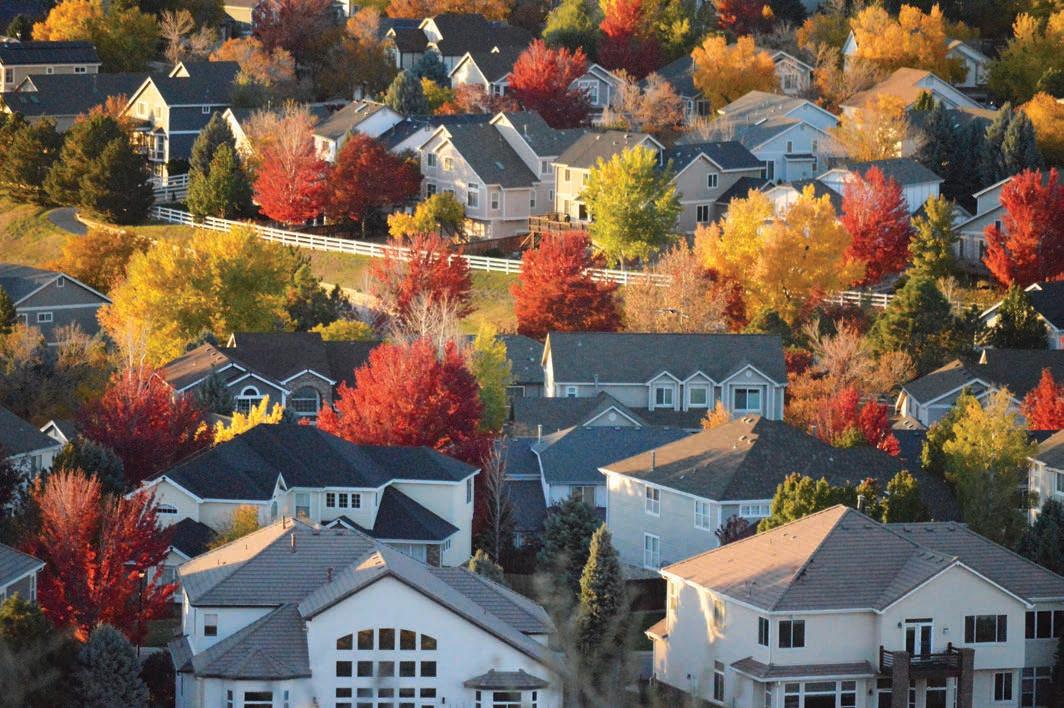
6 minute read
DREAM BIGGER
Reverse-Tier Savings account
$0-$2,000 $2,001-$5,000 $5,001-$10,000 $10,001-$50,000 $50,001-$100,000 $100,001 + even more steeply during the economic trends of the coronavirus pandemic, the Federal Reserve’s raising of interest rates to battle in ation has pushed prices back down. e Fed’s raising of rates is a signi cant — if not the primary — factor driving home prices lower, ayer said.
Interest rates are the amount a lender charges a borrower for a loan, and when they change, it can a ect mortgage rates but also car loans and credit card debt, which can dampen people’s ability to a ord housing, ayer noted.
If the Fed lowers interest rates later this year, it’s di cult to say whether home prices will shoot back up, erasing recent gains in a ordability, ayer said.
“Real estate can vary greatly quarter over quarter. I like to think of it more of a year-over-year trend,” ayer said.

For example, if rates were to return to the level seen in December 2021, home prices in Douglas County in spring 2024 could come back to the highs of spring 2022, ayer said.
A caveat, though, is the broader economic conditions that may arrive. If interest rates go down in response to an overall economic downturn, people might not be spending as much as they did in spring 2022, ayer said.
“But we have such a constrained supply, (including) here in Douglas County,” that prices are also propped up by a lack of available homes, ayer noted.
After a decade, some relief
Although the Denver area and Colorado as a whole have recently seen a big price drop, much of the downslide occurred during the fall and winter, when prices tend to drop each year as homebuying typically slows down after the usual price increases of summer or fall.

Comparing this January to last January, the drop in median price of a single-family home in metro Denver is more modest: a 1.4% decrease. Statewide, the median price was at, a 0% change.
Still, even a slight decrease or attening can come as a relief to Coloradans who have watched prices on a seemingly never-ending climb.
is year saw the rst January-toJanuary, year-over-year decrease in median sales price in the Denver metro area since 2010 to 2011, when price stayed relatively at, according to the Realtor association.
Even amid the recent trends, ayer says a big downward reset in housing prices isn’t for sure.
“On a scale compared to something like 2008? Probably not, because of the place the Denver metro area is in right now,” ayer said. “It is certainly one of the most desirable places to live in the country … so the e ects of a nationwide or global economic downturn are going to be lessened here because of that inherent supply constraint and that inherent (desire) to be here.”
Some type of downturn is likely imminent because the economy is cyclical, ayer said. But he doesn’t foresee a drop in prices of 20% or more in the next 10 years in the Denver metro area relative to the rest of the world.
“I think a 10% drop over the next decade would be more feasible,” said ayer, noting that even that is not necessarily likely.
What’s more, “it wouldn’t be permanent; it would be cyclical,” he noted.
A ordability an issue in Douglas Douglas County’s housing a ordability is low even compared to the rest of the region, with median housing prices around $100,000 higher than the average in the rest of the metro area, ayer said.
“And while we do have higher income, the problem is for those service jobs and all those support roles,” ayer said. He added: “ ere isn’t housing for entry-level jobs or younger people in the service workforce and in those kind of lower- to middle-income careers.”
He sees a “middle ground” in government policy that would incentivize entry-level housing, such as condos, townhomes and duplexes, so local residents can have a place to live where they work. He thinks that will take shape on the city and county level rather than statewide or nationally.
“As a Realtor, we certainly believe in homeownership in the U.S.,” ayer said, “so providing homeownership opportunity not just to high-income households but also to the low- and medium-income households so they can build wealth.” are “not just a problem for Douglas County — it’s a latent problem for all the large counties,” Marshall said.
Commissioners serve as a county’s elected leaders, somewhat similar to city councils. ey make policy decisions that largely a ect parts of the county that are “unincorporated” — areas that sit outside of municipalities.
In Douglas County, which includes Highlands Ranch and many other areas, such as Franktown and Roxborough.
Locally, the idea to add two more commissioners in Douglas County came up in discussion in a county meeting in August. Commissioner Abe Laydon has remained opposed.
“ e last thing counties need are more politicians,” Laydon said in a February statement about the state legislature’s bill. “Whether you have three or 30 commissioners, there will still be a majority and a minority vote unless it’s unanimous.” e counties that would have been a ected by the bill include Je erson, Larimer, Douglas, Boulder, Pueblo and Mesa, all of which have three commissioners.
Five commissioners govern Adams County, but Adams would have been a ected by the bill’s requirement for commissioners to be elected by district, Marshall noted. All ve commissioner seats in Adams are voted on by residents throughout the county — in an “at large” system — rather than voters only casting ballots for the candidates who live in their area.
Ensuring that commissioners are accountable to the people in speci c areas of their county was a key part of the proposal, Marshall said.
“Everyone was saying, ‘Marshall is just trying to get a Democratic commissioner’” elected in Douglas County, Marshall said. But his proposal “doesn’t mean a Republican couldn’t represent Highlands Ranch well.” e Highlands Ranch Metro District provides a limited array of government functions, but many responsibilities fall to the county.
He noted there are conservative areas of Boulder County that may feel “locked out” of decisions without a Republican commissioner.
“It’s just to help political minorities regardless of who they are,” Marshall said.
Representation is an issue particularly in Douglas County because Highlands Ranch makes up roughly 28% of the county’s population, Marshall said.
“When the commissioners are all elected at large, then (Highlands Ranch) really does not have a voice in the county government, which is particularly troublesome” because Highlands Ranch is not a municipality, Marshall said, and relies on the county for many government services.
Bill could return e proposal, state House Bill 231180, was “postponed inde nitely” by a 7-3 vote on March 2 in the House’s State, Civic, Military, and Veterans A airs Committee, stopping the bill from coming to a full vote.


“I think it’s clear that people who had a vested interested in the outcome were more likely to vote against it than people who could (see it) neutrally,” Marshall said.
Among lawmakers on the committee who represented counties that would have been a ected, the bill garnered some support but also saw opposition, according to the vote count.
Marshall said in general that GOP lawmakers “have a very strong ideological view of not letting the state tell local jurisdictions what to do, regardless of what the issue is.”
He noted he’ll likely bring the proposal back in the legislature next year.
“I’m not going to give up,” Marshall said. “I’ll have to just see what the lay of the land looks like in December or January, but yeah, all things being equal, I’ll try again.” e bill would have required that all counties with a population of 70,000 or more have ve commissioners, with at least three commissioners elected only by voters who reside in the district from which each commissioner runs for election. e bill would have allowed counties to choose between three election alternatives:
Other counties already have five Some Colorado counties already operate with ve commissioners. Under current rules, once a county has more than 70,000 residents, a citizen’s group or the county commissioners can put a question on the ballot asking residents if they wish to add two more.
Of the 12 counties who are eligible through their population size, several have moved to ve commissioners, including Adams, El Paso and Arapahoe counties. Weld County and Pitkin County have moved to ve commissioners as part of their home-rule charters — essentially the counties’ own constitutions.
Denver and Broom eld have city council structures with about a dozen members each.
• ree commissioners from three districts elected by residents in those districts and two commissioners elected at large.
• Four commissioners from four districts elected by residents in those districts and one commissioner elected at large.
• Five commissioners from ve districts elected only by residents in those districts.
Pre


TWO A-LIST COMEDIANS FOR ONE LOW PRICE
Chosen for Fest" at Detroit Laugh Fest
NBC's Last Comic Standing and voted "Best in , eclectic mid-westerner

AJ Finney’s personal stream-of-consciousness-storytelling will remind you of the joy of growing up, family, friends, and the beauty of the strange world we live in.


Feature Mitch Jones
Podcaster, aspiring voice actor and avid pop culture enthusiast Mitch Jones has been doing comedy since 2010 but he's been clowning since day one!










